Before independence, the area of Bengal province was 489,500 square kilometres and the population was more than 8 crores. East Bengal (present-day Bangladesh) was almost isolated from West Bengal geographically due to less means of communication. In 1836, the Upper Province of Bengal (present-day Bangladesh) was placed under the rule of a British Lieutenant Governor, and in 1854, the Governor General-in-Council was relieved of the direct administration of Bengal.
Assam, including Sylhet, was separated from Bengal in 1874 to form a separate Chief-Commissionership and later in 1898, the Lushai Hills were also included in it. It was very difficult to manage a large and populous province like Bengal. Therefore, here we are talking about this historical event before independence which is known as the Partition of Bengal.
Beginning of the Bengal Partition
The idea of partition of Bengal was first thought of in 1903. Additional proposals were also made to separate Chittagong and the districts of Dacca and Mymensingh from Bengal and merge them into the province of Assam. Similarly, Chhota Nagpur was also to be merged into the Central Province. In the year 1903 itself, the 19th session of Congress was also held in Madras. On this occasion, its President ‘Shri Lalmohan Ghosh’ in his address criticized the reactionary policy of the government and informed about the imminent disintegration of Bengal on the all-India platform. He said that such a conspiracy was underway.
The government officially publicized the idea in January 1904, and in February Lord Curzon made an official tour of the eastern districts of Bengal to gather public opinion on partition. He consulted prominent figures and gave speeches in Dhaka, Chittagong and Mymensingh to try to convince the government of its stance on partition. Henry John Stedman Cotton, who was Chief Commissioner of Assam between 1896 and 1902, opposed the idea.
Division of Bengal
On 16 October 1905, Bengal was partitioned by the then Viceroy of India, Lord Curzon. Bengal was almost as big as France while its population was much greater than France. In the past, it was thought that the eastern region was neglected and not properly governed. By dividing the province, better administration can be established in the eastern region so that eventually the people there get the benefit of schools and employment opportunities. However, there were other motives behind the partition plan. The Bengalis had been at the forefront of the political movement for greater participation in Hindu rule, so the growing Muslim dominance in the east was now weakening their position.
But despite strong public opposition, on 20 July 1905, the Secretary of India approved the proposal for the disintegration of Bengal. Rajshahi, Dhaka and Chittagong Commissionerates were merged into Assam to form a province called Purbung and Assam.
On this occasion, an attempt was made by the British government to create discord between Hindus and Muslims by saying that this partition would benefit Muslims as they would become the majority in East Bengal and Assam. The Nawab of Dhaka had initially opposed it, but when the Banga was dissolved he became in favour of it. Sir Joseph Bamfield Fuller became the new Lieutenant Governor of East Bengal and Assam. In many places, he is said to have openly stated that he had two wives, a Hindu and a Muslim, of whom the Muslim was his favourite. The meaning of this statement was clear.
Main Objective of Bengal Partition
The main objective of the Bengal Bhang was not to create convenience for the administration, as was claimed, but it had two clear objectives, one to fight the Hindu Muslims and the other to hurt the newly awakened Bengal. If we look deeply, it was from here that the seeds of Pakistan were sown. One of the resolutions passed in the 1906 session of the Muslim League was that the disunion of Bengal was good for the Muslims and those who agitated against it are doing wrong and causing harm to the Muslims.
Let us tell you that in this new province, the hill states of Tripura, Chittagong Division, Dhaka and Rajshahi (except Darjeeling) were included and Malda district was merged into Assam province. Bengal had to give up not only these large eastern areas but also five Hindi-speaking states in favour of the central provinces. On the western side, it was given Sambalpur and five small Oriya-speaking states from the Central Province. Bengal now had an area of only 141,580 square miles (366,700 km2) and a population of 54 million, of whom 42 million were Hindus and 90 million Muslims.
Effect of Partition of Bengal
The partition of Bengal had the following effects on India which were as follows:-
- Due to continuing political conflicts after partition, the two parts of Bengal were reunited in 1911. After this, a new partition took place which divided the province on a linguistic rather than religious basis. Due to this new administrative units were created by separating Hindi, Oriya and Assamese-speaking areas. With this, the administrative capital of British India was shifted from Calcutta to New Delhi.
- In 1919, separate electoral systems were established for Muslims and Hindus. Earlier, many members of both communities had advocated national unity for all Bengalis. Now, different communities have developed their political issues.
- After this, the demand for the creation of two independent states for Hindus and Muslims started rising at the national level, most of the Bengali Hindus now started favouring the partition of Bengal based on the Hindu majority area and Muslim majority area.
- In 1947, Bengal was divided for the second time, again on religious lines. Which later became East Pakistan (present-day Bangladesh). However, in 1971, after a successful liberation war with West Pakistani military rule, East Pakistan became an independent country named Bangladesh.
- This also created a big political crisis. The Muslims of East Bengal believed that a separate region would provide them with more opportunities for education, employment, etc., while the people of West Bengal did not like this partition and a large amount of nationalist literature was composed during this period.
The Movement against the Partition of Bengal
There were big movements outside Bengal also against the partition of Bengal. Famous poets and litterateurs of the country played an important role in this movement. This movement gave new heights to Bankimchandra Chattopadhyay’s song ‘Vande Mataram’. At that time, the British conspiracy to divide Bengal was not only broken, but it also gained extraordinary fame in the country and abroad. Countries like Germany and Canada were also affected by this.
End of Bengal Partition
A Durbar was held in Delhi on 12 December 1911, attended by Emperor George V, Queen Mary and the Secretary of State for India, Lord Crewe. On the occasion of this durbar, a royal proclamation was issued ordering the unification of the Bengali-speaking areas of West and East Bengal into one province. With this, the British government changed its capital from Calcutta to Delhi.
FAQs
Question: When and who partitioned Bengal?
Answer: The then Viceroy of India, Lord Curzon, officially announced the partition of Bengal on 20 July 1905.
Question: When did the partition of Bengal end?
Answer: The partition of Bengal was cancelled in 1911 due to persistent political opposition in the country.
Question: Why did the partition of Bengal have to be cancelled?
Answer: Curzon left India and went to Britain in the year 1905, but this movement continued for many years. Ultimately, due to increasing opposition, in the year 1911, Lord Hardinge announced the cancellation of the partition of Bengal.
Question: Who cancelled the partition of Bengal?
Answer: In 1911, Lord Hardinge cancelled the partition of Bengal because riots and violence were taking place all around in protest against the partition.
Question: When and why did India get divided?
Answer: The partition of India was done based on the Mountbatten Plan under the Indian Independence Act of 1947.
Also Read:
- What is the History of Tea in India and how did it Start?
- Know About the Moon to Mars Program: Overview







